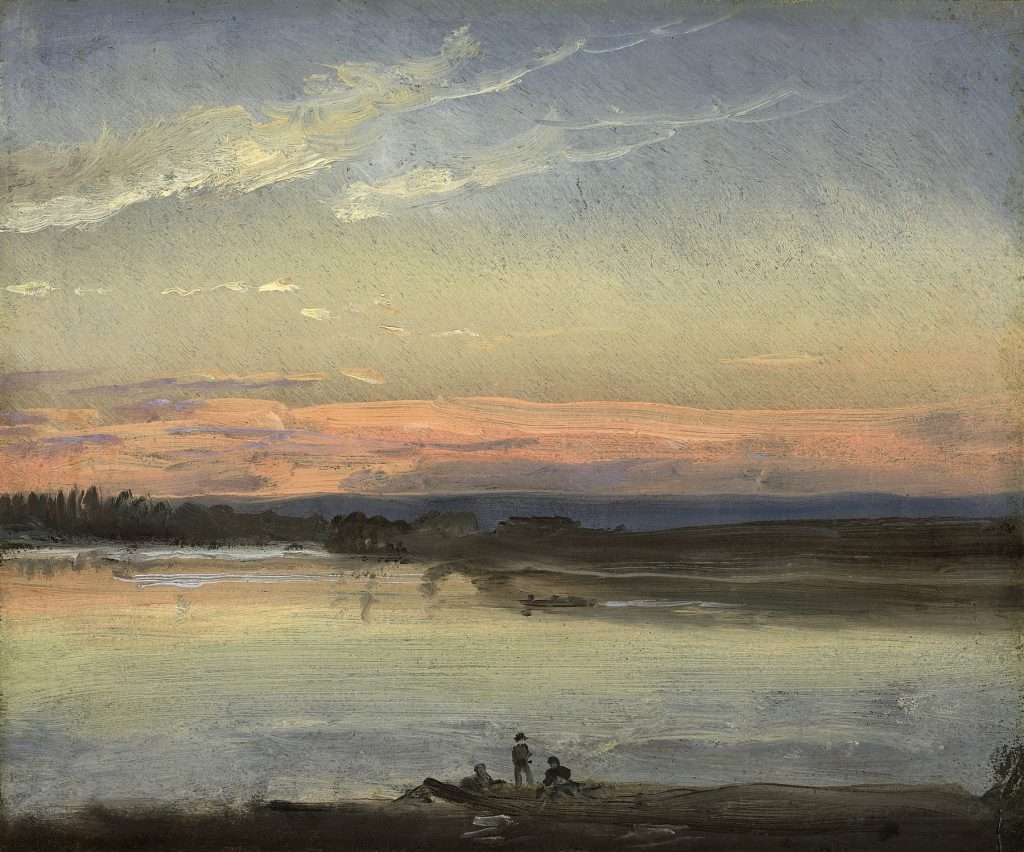Johan Christian Clausen Dahl (Bergen 1788 - 1857 Dresden)
Sunset over the River Elbe, Dresden, c. 1840
Oil on paper, laid down on canvas, 17 x 20.4 cm
Reverso on the stretcher: Label handwritten inscribed by Sigwald Dahl, the artist’s son Abendlandschaft an der Elbe bei Dresden. Naturstück von J.C.C. Dahl
Provenance:
Caroline Bull (the artist’s daughter)
General Siegwald Bull (son of the above)
Thence by descent
Literature:
Marie Lødrup Bang, Johan Christian Dahl, 1788-1857. Life and Works, Catalogue Raisonné, Oslo 1987, vol. II, p. 363, no. 1271 and vol. III, pl. 545
Johan Christian Dahl had already completed his training as a landscape painter when he left his native Norway for Copenhagen in 1811 to enter the Copenhagen Academy of Fine Arts. A pupil of C. A. Lorentzen, his main interests lay in seventeenth-century Dutch landscape painting and in the study of Eckersberg’s views of Rome. In 1818, he set out on a Grand Tour. One of his stops was Dresden, where he moved in artistic circles and met the celebrated German painter Caspar David Friedrich. In the summer of 1820 he travelled to Rome and Naples, returning in 1821 to settle permanently in Dresden. From 1823 onwards he lived in the same house as C.D. Friedrich.[1] He was one of three outstanding Dresden painters of the period – the others being C.D. Friedrich and Carl Gustav Carus. The three exerted a decisive influence on German Romantic painting.
In Dahl’s finished works his scientific interest is subordinated to his licentia poetica – his perception of pictorial effect. This is less true of his plein-air sketches, such as the present work, where the primary interest is directed towards a specific state of the weather, a specific cloud formation and a specific light effect created by the sun or moon. [2]
Growing scientific interest in meteorology in early-nineteenth century England encouraged a number of artists to study cloud formations and atmospheric effects in detail. John Constable’s cloud studies are the best-known examples, but artists and thinkers were beginning to show lively interest in the subject in Saxony, too. Goethe himself introduced Dahl’s friend, the physician, scientist and artist C.G. Carus, to the subject. Aubert[3] records that Goethe lent Dahl a copy of Luke Howard’s key work, On the modification of clouds.[4]
Dahl’s stay in Italy further stimulated his interest in plein-air studies - an interest that was to become a major focus of his output in the following twenty years. He developed techniques that allowed him to work quickly to capture fleeting weather conditions. This is impressively exemplified in a group of three sketches of cannon smoke billowing above the guns at an Easter Sunday salute in 1831.[5]
[1] Catherine Johnston et al., in Baltic Light - Early Open-Air Painting in Denmark and North Germany,
exhib. cat., New Haven and London, 1999-2000, p.43.
[2] For related sketches of the 1840s, equally loose in their brushwork, see Wogen-Wolken –Wehmut. Johan Christian Dahl 1788-1857, exhib. cat. Schleswig-Holsteinisches Landesmuseum, Schloß Gottorf, 2002, and Munich, 2002, cat. 65, 68; Johan Christian Dahl, 1788-1857. Ein Malerfreund Caspar David Friedrichs, exh. cat. Neue Pinakothek, München, 1988-1989, cat. 93 [3] Andreas Aubert published two authoritative works on Dahl, a biography in 1894 and a study of his paintings in 1920. [4] Marie Lødrup Bang, in exhib. cat. Johan Christian Dahl, op. cit. p.264. [5] Exhib. cat. Johan Christian Dahl, op. cit., cat. 74
